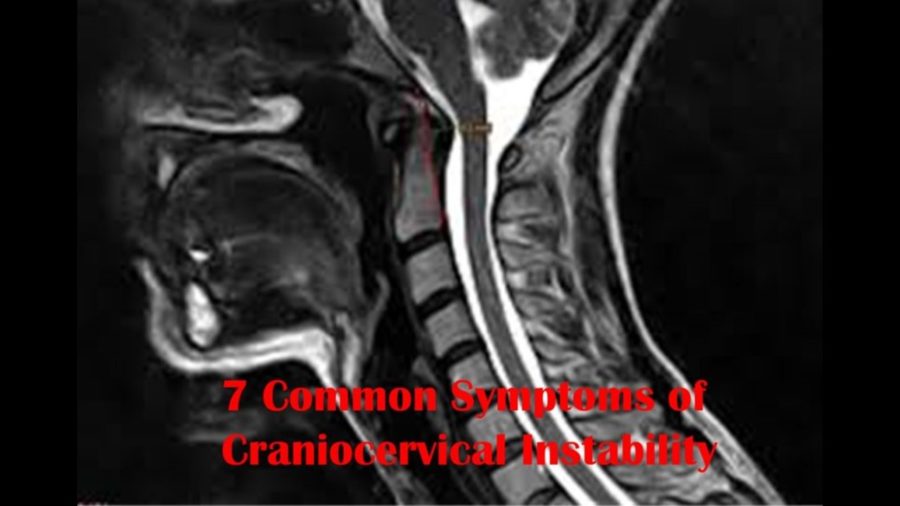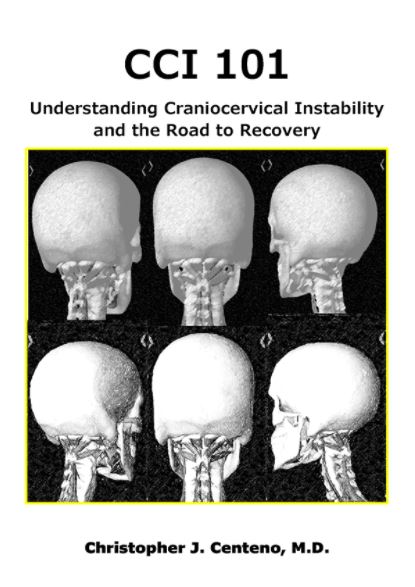The headaches and neck pain are getting worse. PT, massage, and medications did not help. All the imaging studies are normal. Your doctors are baffled. What is Craniocervical Instability? What are the most common Craniocervical Instability Symptoms? What are the treatment options for Craniocervical Instability? Let’s dig in.
What Is Craniocervical Instability?
Craniocervical Instability (CCI) is a medical condition where the strong ligaments that hold your head to your upper neck are loose or lax (1). The major ligaments involved are the Alar, Transverse and Accessory ligaments. To learn more about CCI please click on the video below.
Craniocervical Instability Symptoms
Excessive movement between your head and neck can cause movement and damage of upper cervical facet joints, discs, nerves, and blood vessels. Symptoms vary depending upon the amount of instability. Common Craniocervical Instability symptoms include:
1. Painful, Heavy Head
A constant to near-constant head pain that can be described as feeling like the head is too heavy for the neck to support. Many describe feeling like they have a “bobble-head”.
2. Headache
This is not your normal headache caused by your in-laws or excessive consumption of alcohol. This is a debilitating headache that is constant in duration and miserable. Headache is often caused by the upper neck joints, muscles, and tendons getting injured due to ongoing instability.
3. Rapid Heart Rate
Elevated heart rate may occur as the vagus nerve gets irritated by the extra motion in the upper neck. Another cause of elevated heart rate is Postural Orthostatic Tachycardia Syndrome (POTS). POTS is a medical condition that causes malfunction of the autonomic nervous system. It is estimated to impact between 1,000,000 and 3,000,000 Americans. The autonomic nervous system controls involuntary body functions such as heart rate and blood pressure. Malfunction of the autonomic nervous system causes a number of symptoms which include rapid heart rate.
4. Brain Fog
Patients with CCI can struggle with memory, concentration, and ability to complete tasks. Every day can feel like your brain is stuffed full of cotton.

5. Neck Pain
Pain is typically localized at the base of the skull and aggravated with flexion and rotation. The pain can shoot up into the base of the skull, top of the head, frontal area or behind the eyes.
6. Visual Problems
Visual disturbances can vary from mild to severe involving a number of symptoms. Visual disturbances can happen because the upper neck supplies information to the brain to guide eye position and vice versa (2).
7. Dizziness
Balance problems can be a significant issue (3). Dizziness or imbalance is a feature related to the fact that the upper neck is a major contributor to balance (4). The upper neck provides a position sense that has to be coordinated with balance information from the eyes and inner ear.
Deep Dive Into CCI Symptoms
Arm Pain at Night
Arm pain at night can be miserable. The pain can interrupt your sleep and erode your quality of life. Irritability becomes increasingly more common. What are the causes? When should I worry about it? What are the treatment options for arm pain at night? The neck is composed of 7 boney building blocks numbered 1- 7. Sandwiched between the bones is a disc that functions as an important shock absorber. The cervical discs are susceptible to injury due to trauma, degeneration, repetitive motion, and surgery. Common disc injuries include disc bulges, and herniations. The injured disc can compress or irritate one or more nerves resulting in arm pain at night. It can…
Read More About Arm Pain at NightBrain Fog
Brain fog is one of the hallmark symptoms of Craniocervical instability. It is characterized by slow thinking, difficulty focusing, confusion, lack of concentration, forgetfulness, or haziness in thought. The severity of symptoms varies from patient to patient. Ever had a bad hangover or high fever and had trouble concentrating or completing simple tasks? This brain fog. Some patients describe it as a generalized haziness in thought as if cotton were stuck in the head. In addition to cognitive impairments, many patients also report generalized mental fatigue making complex tasks almost impossible. The exact cause of brain fog is unknown. Possible explanations include…
Read More About Brain FogCervicalgia / Neck Pain
Cervicalgia is also known as neck pain, which is an all-too-common, unpleasant pain. Read here to learn the symptoms, diagnosis, and treatment options. We will discuss other causes for cervicalgia. What symptoms are associated with cervicalgia? How is cervicalgia diagnosed? What are the treatment options for cervicalgia? Cervicalgia is a medical term used to describe neck pain. It is very common and affects approximately 2/3 of the population at some point in their life. Cervicalgia is the 4th major cause of disability. Risk factors include injury, prior history of neck and musculoskeletal pain, jobs that require a lot of desk work, low social support, job insecurity, physical weakness, and poor computer station setup.
Read More About Cervicalgia / Neck PainChronic Fatigue
Have you ever had a challenging all-day hike, athletic endeavor, or worked a double shift and felt exhausted the next day? Later that day or the next morning, moving across the room may have seemed almost impossible and took herculean power. Now image this occurs on a daily basis without any provocation. 24/7 simple tasks are nearly impossible due to a lack of strength and energy. This is chronic fatigue, and it is one of the common symptoms associated with craniocervical instability. Severity can vary and in severe cases, patients are confined to their beds. Aggravating and alleviating factors often times can not be identified.
Read More About Chronic FatigueChronic Headaches
Do you suffer from chronic headaches? Maybe it’s a daily issue, maybe once a week, maybe even less often, but one thing’s for sure—when a chronic headache kicks in, it can be a real pain in the neck, literally. In order to effectively address chronic headaches, you have to first determine if the pain is caused by a problem in your neck. Let’s take a look at a few neck issues that can cause headaches: Weak neck muscles – The head, on average, weighs about ten pounds, so when the neck muscles are weak, it can make your head feel a bit like a bowling ball that your neck can’t quite balance. There are many muscles that, along with the cervical spine, work together to help support the neck and aid movement…
Read More About Chronic HeadachesGastrointestinal (GI) Problems
Gastrointestinal (GI) problems can be debilitating comprising one’s wellbeing and ability to confidently engage in life. Symptoms vary and can include nausea, bloating, constipation, diarrhea, delayed motility, abdominal pain, irritable bowel-like symptoms, heartburn, and reflux. GI problems can be due to structural and functional problems within the gut itself. Examples include hiatal hernia and bacterial overgrowth. Less appreciated is the fact that many patients with Craniocervical instability (CCI) can also have significant GI problems. Regrettably, many of these patients undergo extensive, costly GI evaluations only are told that their examinations and studies are normal. This can be extremely frustrating. For these patients…
Read More About Gastrointestinal (GI) ProblemsJugular Vein Compression
The internal jugular vein is a major vein in the neck that carries deoxygenated blood from the head and face back to the heart. Due to its location, it is susceptible to compression from various structures in the neck, including muscles, bones, and ligaments.One of the main causes of jugular vein compression is thought to be craniocervical instability (CCI), a condition caused by the misalignment of the upper neck bones C1 and C2 that can lead to symptoms such as dizziness, headaches, poor balance, fatigue, tinnitus, and more. The following is an in-depth examination of jugular vein compression symptoms, how it is caused…
Read More About Jugular Vein CompressionMuscle Pain After Cervical Fusion Surgery
Cervical Fusion is a major surgery that involves joining one or more of the spinal bones together using screws, bolts, and plates (1). The hardware may be placed in the front (anterior) or the back( posterior) of the cervical spine. The disc between the spinal bones is often times removed and replaced with a bone graft or a spacer. The neck of composed of 7 boney building blocks that are numbered from 1-7. The letter C is associated with the numbers to designate the cervical spine. Hence the bones in the neck are C1 through C7. Sandwiched between neck bones are important shock absorbers called discs. A cervical fusion surgery removes…
Read More About Muscle Pain After Cervical Fusion SurgeryNeck Pain And Dizziness
Our body’s balancing system is compromised of three separate systems that work closely together to keep the body in balance: the eyes, inner ear, and upper cervical spine. The upper cervical spine contains and processes information about your position in space and communicates this information to your eyes and inner ears via nerves. There is a constant highway of electrical signals between the cervical spine, inner ear, and eyes that keep us upright, make us aware of our position and enable us to walk, move and run. This balancing system requires the inner ear, eyes and cervical spine to be operational…
Read More About Neck Pain And DizzinessPain At The Base Of The Neck And Skull
The base of the skull is a complex area. It involves the upper cervical spine, facet joints, muscles, tendons, ligaments, and nerves. Irritation or injury to any one of these structures can result in pain at the base of the skull. Unfortunately, this area is not understood by many providers. This can lead to a delay in treatment and unnecessary pain and suffering.Treatment options depend upon the underlying cause of the pain. Conservative therapy in the form of physical therapy when appropriate is the best first-line treatment. Steroids are often recommended but should be avoided as they are toxic to orthopedic tissue and have significant side effects…
Read More About Pain At The Base Of The Neck And SkullPain In The Left Side Of The Neck
Understanding the causes of left-sided neck pain is crucial for proper diagnosis and treatment. Left-sided neck pain can result from several factors, including musculoskeletal issues, nerve compression, trauma, inflammation, or underlying medical conditions. Muscular strains, poor posture, and stress are common causes of neck pain. Additionally, conditions such as cervical disc herniation, cervical spinal stenosis, and osteoarthritis can lead to left-sided neck pain. According to global estimates, neck pain affects a significant portion of the population. In the United States alone, it has been reported that about 10% to 15% of individuals experience neck pain at any given time. Neck pain can occur in people of all ages, although it tends to be more prevalent in adults.
Read More About Pain In The Left Side Of The NeckRapid Heart Rate
Rapid heart rate can be debilitating, compromising your wellbeing and ability to complete the easiest of tasks, and, unfortunately, it is a common symptom of craniocervical instability or other upper cervical conditions. Normal resting adult heart rate ranges from 60-85 beats per minute. Tachycardia is a medical term for heart rates of 100 beats per minute. Most of us have experienced rapid heart rates after vigorous exertion or exercise. Remember how your heart was rapidly beating after wind sprints or chasing after your dog who jumped the fence? Your heart is rapidly pounding in your chest. Unfortunately for some patients that is their baseline.
Read More About Rapid Heart RateStiff Neck
A painful stiff neck affects one in three people every year, and is most prevalent in the 35-49-year age group. It causes significant disability for all those affected, but is more commonly seen in women. A stiff neck can be a symptom of vascular disease, inflammatory disorders, infection, and malignancy. Therefore, it needs to be evaluated properly before any treatment begins. In this article, we’ll discuss what causes a painful stiff neck, how to diagnose it, and some common treatments.
Read More About Stiff NeckTinnitus
Remember the ringing in your ears after a loud rock concert or highly charged sporting event? It is that ringing or buzzing sound that slowly improves the next day over several hours. Unfortunately for some individuals, the ringing in the ears is not due to an external event. Even worse is it does not resolve over time. This condition is called tinnitus. It is a medical condition characterized by ringing or other noises in one or both ears NOT caused by an external sound. Other individuals cannot hear the ringing that patients describe. It is a common problem. It affects approximately 15-20% of individuals.
Read More About TinnitusDiagnosing Craniocervical Instability
In a previous blog, I reviewed the 7 main criteria used in establishing the diagnosis of cranial cervical instability. They are:
- Mechanism of Injury
- Symptoms
- Physical Examination
- Radiographic studies
- Response to Conservative Care
- Response to Diagnostic Injections
- Level of Disability
Treatment Options for Craniocervical Instability
In 2015 a nonsurgical treatment option for cranial cervical instability was developed at the Centeno-Schultz Clinic. It involves the injection of a patient’s own bone marrow-derived stem cells into the damaged alar, transverse ligaments. The procedure is very demanding and only performed at the Centeno-Schultz Clinic in Broomfield Colorado. The procedure is called Percutaneous Implantation of Cervical Ligaments (PICL) To learn more about this groundbreaking procedure please click on the video below.
In Conclusion
Craniocervical Instability (CCI) is a medical condition where the strong ligaments that hold your head to your upper neck are loose or lax. This can involve the alar, accessory, and transverse ligaments. Craniocervical Instability Symptoms vary depending upon the amount of instability. The 7 most common symptoms are a painful heavy head, headache, rapid heart rate, brain fog, neck pain, visual problems, and dizziness. The main criteria for diagnosing craniocervical instability has been previously discussed in a separate blog.
Craniocervical instability, if left untreated, can result in a progression in symptoms and injury to the cervical discs, facets, muscles, and nerves. In severe cases, patients are housebound due to their level of dysfunction and symptoms. Employment, relationships, and joy often times are eroded.
If you or a loved one has sustained an injury with symptoms that baffled your community physicians please schedule a telemedicine consultation. A board-certified, fellowship-trained physician will review your history and imaging to determine your candidacy for nonsurgical treatment options. Act now before the symptoms and dysfunction progress.
1.Offiah CE, Day E. The craniocervical junction: embryology, anatomy, biomechanics and imaging in blunt trauma. Insights Imaging. 2017;8(1):29–47. doi:10.1007/s13244-016-0530-5
2.Ischebeck BK, de Vries J, Van der Geest JN, et al. Eye movements in patients with Whiplash Associated Disorders: a systematic review. BMC Musculoskelet Disord. 2016;17(1):441. Published 2016 Oct 21. doi:10.1186/s12891-016-1284-4
3. Biesinger E. and Vertigo caused by disorders of the cervical vertebral column. Diagnosis and treatment. Adv Otorhinolaryngol. 1988; 39: 44– 51.
4. Thompson-Harvey A, Hain TC. Symptoms in cervical vertigo. Laryngoscope Investig Otolaryngol. 2018;4(1):109–115. Published 2018 Nov 28. doi:10.1002/lio2.227
5. This article





